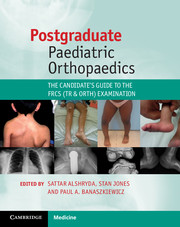Book contents
- Frontmatter
- Contents
- List of contributors
- Foreword
- Preface
- Acknowledgements
- Interactive website
- List of abbreviations
- Section 1 General guidance
- Section 2 Core structured topics
- Chapter 3 The hip
- Chapter 4 The knee
- Chapter 5 The foot and ankle
- Chapter 6 The spine
- Chapter 7 The shoulder
- Chapter 8 The elbow
- Chapter 9 Congenital hand deformities
- Chapter 10 Neuromuscular diseases
- Chapter 11 Musculoskeletal infections
- Chapter 12 Musculoskeletal tumours
- Chapter 13 Skeletal dysplasia
- Chapter 14 Metabolic bone disease
- Chapter 15 Physis and leg length discrepancy
- Chapter 16 Deformity corrections
- Chapter 17 Miscellaneous paediatric conditions
- Section 3 Exam-related material
- Index
- References
Chapter 9 - Congenital hand deformities
Published online by Cambridge University Press: 05 August 2014
- Frontmatter
- Contents
- List of contributors
- Foreword
- Preface
- Acknowledgements
- Interactive website
- List of abbreviations
- Section 1 General guidance
- Section 2 Core structured topics
- Chapter 3 The hip
- Chapter 4 The knee
- Chapter 5 The foot and ankle
- Chapter 6 The spine
- Chapter 7 The shoulder
- Chapter 8 The elbow
- Chapter 9 Congenital hand deformities
- Chapter 10 Neuromuscular diseases
- Chapter 11 Musculoskeletal infections
- Chapter 12 Musculoskeletal tumours
- Chapter 13 Skeletal dysplasia
- Chapter 14 Metabolic bone disease
- Chapter 15 Physis and leg length discrepancy
- Chapter 16 Deformity corrections
- Chapter 17 Miscellaneous paediatric conditions
- Section 3 Exam-related material
- Index
- References
Summary
The development of the upper limb begins during the fourth week of life in utero, when a limb bud, consisting of undifferentiated mesenchymal cells encased in ectoderm, develops. By 9 weeks, the bud has developed into an arm and hand with identifiable digits, and by 12 weeks the digits have differentiated.
Growth and differentiation are under the control of signal regions at the tip of the developing limb with complicated interactions and feedback systems (Figure 9.1). Induction of mesenchymal cells in the ‘progress zone’ at the tip of the developing limb occurs under the influence of specific zones. The apical epidermal ridge (AER) is the director of growth in the proximodistal axis (excision of the AER results in a limb stump only, while transplantation may result in a duplicate limb). Differentiation in the radioulnar axis is under the control of the zone of polarizing activity (ZPA) (transplantation of the ZPA can give rise to a ‘mirror hand’). Differentiation in the volardorsal axis is under the control of the dorsal ectoderm (excision and rotation of this zone causes dorsal muscles to form ventrally). Thus, there is a complicated interaction between genes and the proteins they encode, which induces the cells of the AER, ZPA and dorsal zone that drive limb developing and patterning. Anomalies in these processes result in anomalies in limb development, and may be the result of genetic mutation, interruption of a pathway at molecular level or gross insult. The aetiology of such insults can be environmental, e.g. radiation, infection or chemical (including drugs), or hereditary, as part of a syndrome.
- Type
- Chapter
- Information
- Postgraduate Paediatric OrthopaedicsThe Candidate's Guide to the FRCS (Tr and Orth) Examination, pp. 146 - 164Publisher: Cambridge University PressPrint publication year: 2014

